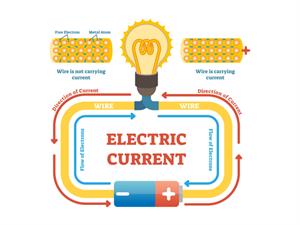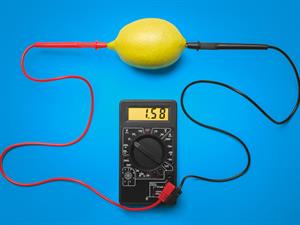PDF chapter test TRY NOW
Electric current:
The flow of electric charges in a circuit or material constitutes an electric current. For an electrical appliance to work, an electric current must flow through it.
An electric current is measured by the amount of electric charge moving per unit time at any point in the circuit. The symbol ‘\(I\)’ is used to denote the electric current.

Flow of electrons in a conductor

Flow of electrons in a circuit
Unit of Electric Current
Electric current (\(I\)) is mathematically written as,
\(I\) \(=\) \(q\)\(/\)\(t\)
The unit of charge \(q\) is a \(\text{coulomb}\), and it is denoted by '\(C\)'.
The unit of time is \(\text{second}\), and it is denoted by '\(S\)'.
Therefore, the unit of electric current is \(C/S\) or \(\text{Ampere}\). Ampere is the name of a scientist.
Is it possible to produce electricity at home?
Yes, it is possible to produce electricity at home, but we can produce a minute quantity only. When a zinc and copper electrodes are inserted in fruits such as lemons, oranges, apples, grapes, and bananas, those copper and zinc electrodes act as positive and negative terminals when the electrodes' ends are connected to the external circuit, then current flows through the circuit.
Yes, it is possible to produce electricity at home, but we can produce a minute quantity only. When a zinc and copper electrodes are inserted in fruits such as lemons, oranges, apples, grapes, and bananas, those copper and zinc electrodes act as positive and negative terminals when the electrodes' ends are connected to the external circuit, then current flows through the circuit.

Sample circuit
Example:
1. Calculate the current in an electric wire, if \(40\) \(coulomb\) of charge flows in \(60\) \(seconds\).
Given:
Charge (\(q\)) \(=\) \(40\) \(coulomb\)
Time (\(t\)) \(=\) \(60\) \(second\)
Current (\(I\)) \(=\) \(?\)
Solution:
\(I\) \(=\) \(q/t\)
\(I\) \(=\) \(40/60\)
\(I\) \(=\) \(0.66\) \(A\)
Therefore, \(0.66\) \(A\) current flows in the electric wire.
